Jetboil’s camping cooking systems integrate a cook pot and stove into a highly efficient, easy-to-use, fast, and completely self-contained cooking system. Below, we explain how to choose between the different Jetboil cooking systems so you can find the one that best suits your needs and budget. Jetboil stoves completely transformed backpacking stoves when they first came out and demonstrated the convenience of having a highly integrated “stove system” instead of separate components from different manufacturers.
Specs at a Glance
Jetboil Flash Cooking System
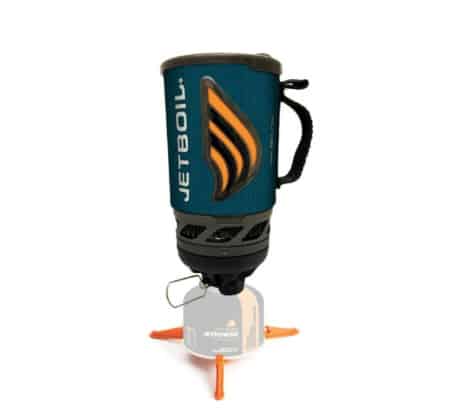
The Jetboil Flash is designed to boil water fast and as a result, it’s perfect for making coffee and rehydrating freeze-dried backpacking meals. The Flash has an insulated 1.0L cook pot with a built-in wind guard that increases fuel efficiency by 30% and comes with a plastic measuring cup, stabilizer stand, and a push-button igniter. A heat-sensitive logo turns orange when water is boiled, while a wire flame control valve lets you adjust the flame height. While you can rehydrate soupy meals like ramen noodles in the integrated Flash pot, you must be careful to avoid boilovers. The Flash is ideal for 1 person and will boil 8-10 liters of water with a small 100 g fuel canister.
Jetboil Stash Cooking System
The Jetboil Stash is a 7.1 oz fully integrated personal cook system with a titanium stove, an anodized cook pot w/lid, and a stand. It’s much less powerful than the Jetboil Flash listed above but also much smaller, lighter weight, and packable which is the reason it’s such an attractive option. However, the cooking pot does not have an insulated sleeve to reduce weight. When not used, the stove, stand, and a 100g oz gas canister fit inside the cookpot, making the Stash remarkably easy to pack. The Stash can boil a half-liter of water in 2 minutes 30 seconds and boil up to 12L on one small fuel canister.
Jetboil Zip Cooking System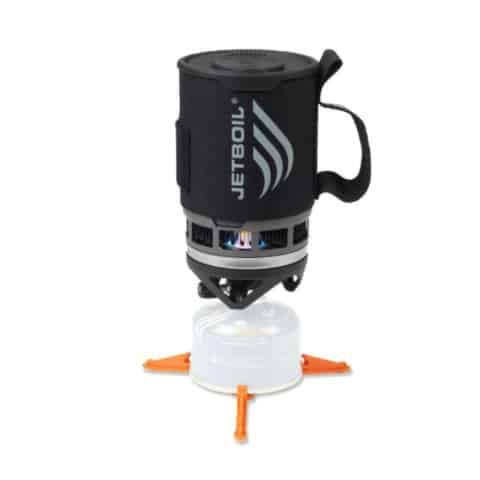
The Zip is Jetboil’s least expensive and most popular single-person cooking system. It’s nearly identical to the Jetboil Flash in appearance but has a smaller 0.8L pot and a stove that’s 50% less powerful, so it takes longer to about a minute longer to boil 2 cups of water. There’s also no built-in igniter, so you must light it with a match, lighter, or fire steel. The Zip is ideal for a single person and is slightly lighter than the Flash. Personally, I prefer the Zip over the Flash because it packs up smaller. I can pack a 100 g fuel canister inside the pot, so it’s easy to throw into a backpack or my car whenever I want to carry a stove on a trip. Push-button igniters all wear out and fail eventually, so not having one is one less thing that will break.
Jetboil MicroMo Cooking System
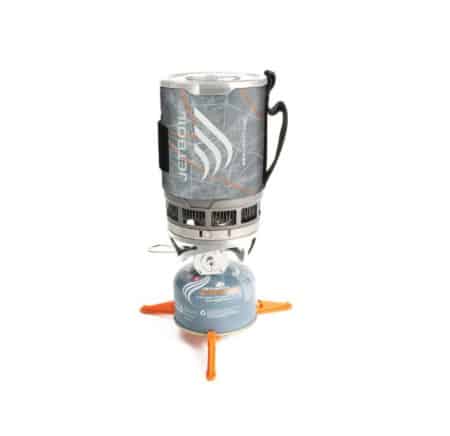
The Jetboil MicroMo has the same pot size as the Jetboil Zip, but its stove has more power, comes with a push-button igniter, and has a built-in pressure regulator, so it’s better for cold weather use. The pressure regulator helps maintain a steady fuel flow from a canister to the stove as the gas pressure in the canister drops. This occurs when the outside temperature falls or as the gas in the canister is used up. The MicroMo will still only burn canister gas down to about 20 degrees Fahrenheit, but it will burn hotter and more forcefully than the unregulated Zip or Flash stoves until the pressure in the canister drops below the minimum pressure required by the stove to operate. The MicroMo is also designed to simmer, so you can cook things like scrambled eggs or pasta with cream sauce, although it’s easier to do this with the Jetboil MiniMo. Like the Zip, you can expect to get boil 12 liters of water with a 100 g fuel canister.
Jetboil MiniMo Cooking System

The Jetboil MiniMo is similar to the MicroMo except that it has a larger and wider 1L cook pot that makes it easier to cook with. It also has the same built-in igniter, pressure regulator, stove, and simmer control as the MicroMo. If you plan on simmering food for one or two people, the MiniMo’s shape is much easier to cook with because the squat shape makes it easier to stir the contents with a spoon.
Jetboil SUMO Cooking System
The Jetboil SUMO has the same features as the MiniMo, but with a 1.8L cook pot instead of a 1.0L one. It’s designed for couples or small groups, but is underpowered for that task, with the same 6000 BTU power stove as the MiniMo and MicroMo. While you can simmer with the SUMO, I’d recommend upgrading to the 10,000 BTU Jetboil MightyMo stove if you plan to cook for more than two people or want to use wider and higher capacity pots and pans for meal preparation.
Jetboil MightyMo Cooking System
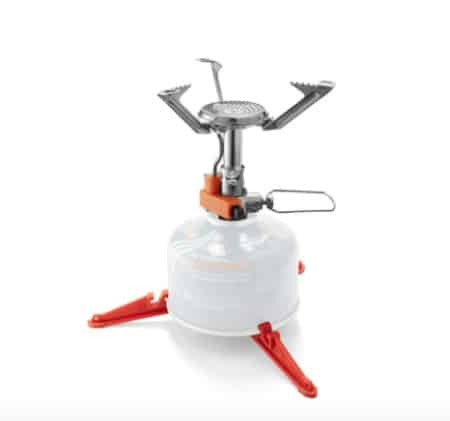
]The Jetboil MightyMo is a powerful but standalone isobutane canister stove with a 10,000 BTU output. This is useful if you want to boil a big pot of water fast for hungry scouts. The MightyMo can be used with third-party cook pots and skillets from other manufacturers although it is optimized for use with the giant Jetboil 5L Fluxring cook pot, the smaller Jetboil FluxRing 1.5L cook pot, and the FluxRing Frying Pan, which require less fuel to heat than conventional cooking pots.
Feature Comparison
Jetboil Genesis Basecamp Cook System

The Genesis Basecamp Cook System burns propane (in the green 16.4 oz bottles) like many traditional camping stoves instead of isobutane canister gas. It includes two burners, a 5L cook pot, and a 10″ skillet, that fold together into a compact stacked unit that’s easy to pack in a backpack for basecamp cooking. Try that with a class Coleman 2 burner stove! The two stoves are compatible with Jetboil’s Fluxring pots as well as regular cook pots from other manufacturers. Both stoves have igniters, regulators, and simmer controls like Jetboil’s other high-powered stoves. They both run off the same propane canister and are easy to dismantle for cleaning. A windscreen and carry case is also included. Personally, I think this stove system is outrageously expensive, although it packs up way more conveniently in a backpack than other propane-powered options.
Jetboil HalfGen Basecamp Cook System
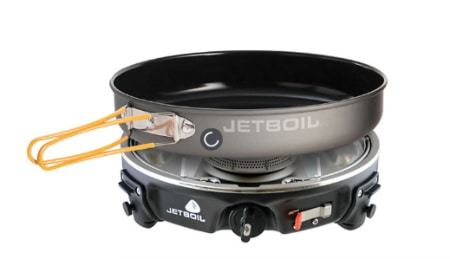
The HalfGen Basecamp Cook System can be used by itself or as part of a larger basecamp cook system like Genesis Basecamp System by daisy-chaining stoves off the same propane canister. It comes with a 9″ skillet good for cooking pancakes or frying fish, but can also be used with Jetboil’s Fluxring pots or pots and pans from other manufacturers. It has 10,000 BTUs of heat output, a regulator, an igniter, and simmer control like the Genesis. A windscreen and carry case is also included. Like the Genesis 2 above, I think this stove system is way overpriced and my preference would be to pack a frying pan and a regular simmering isobutane canister stove.
Feature Glossary
BTU stands for British Thermal Unit and measures the heat output of stoves and fuels. A single BTU is the heat required to raise 16 ounces of water one degree Fahrenheit. Isobutane canister camping stoves typically produce between 4000 and 11000 BTUs.
Cooking System. Also called a Stove System. An integrated set of components required for camp cooking that pack up together into a compact unit. It usually includes a stove, pot, pot cozy, pot handles or a gripper, pot lid, scrubbing brush, measuring cup, and pot stand. Some cook systems are also large enough to pack a fuel canister inside for easy transport.
Igniter. Also called a Piezo-Igniter. Produces a spark to ignite your fuel without matches or a lighter. They wear out with use but can be replaced on some stoves. Igniters are often left off basic models and included as a higher-end feature on canister stoves.
Fluxring. Also called Heat Exchange Coils or Fins. These are metal coils soldered to the base of a cooking pot to hold heat and transfer it to the cooking pot even when the stove has been turned off. They also provide wind protection and have the potential to reduce fuel requirements by 30%.
Regulator. Also called a Stove Regulator. Stove regulators help ensure a constant flow of fuel to a stove even as the pressure inside a gas canister drops. This ensures constant performance and boiling times, even as the fuel contents of a gas canister are used up.
Simmering. Slow cooking that’s short of boiling.
SectionHiker is reader-supported. We only make money if you purchase a product through our affiliate links. Help us continue to test and write unsponsored and independent gear reviews, beginner FAQs, and free hiking guides.


